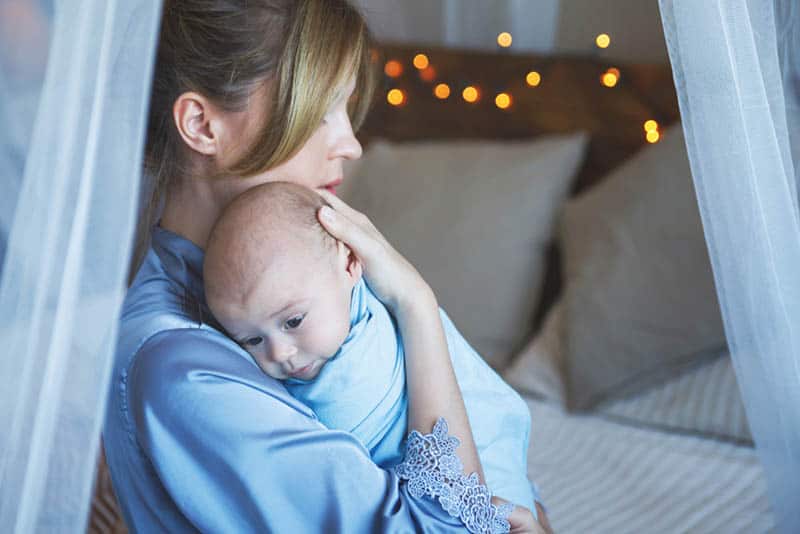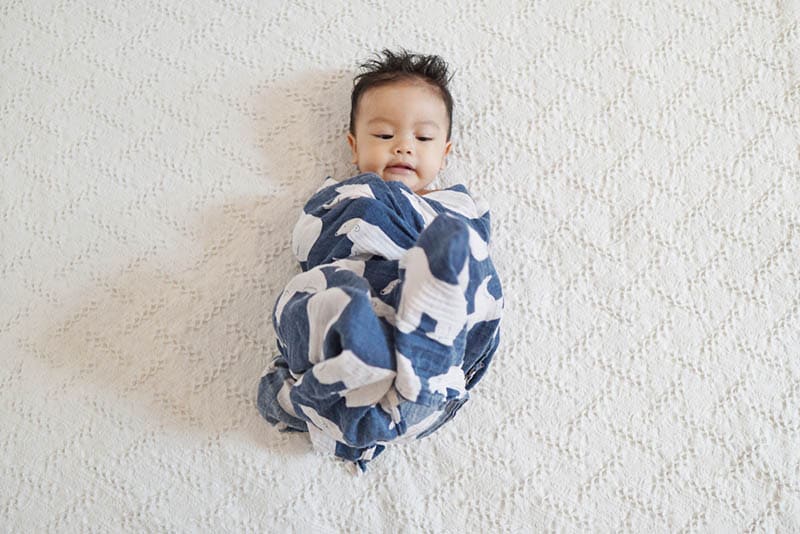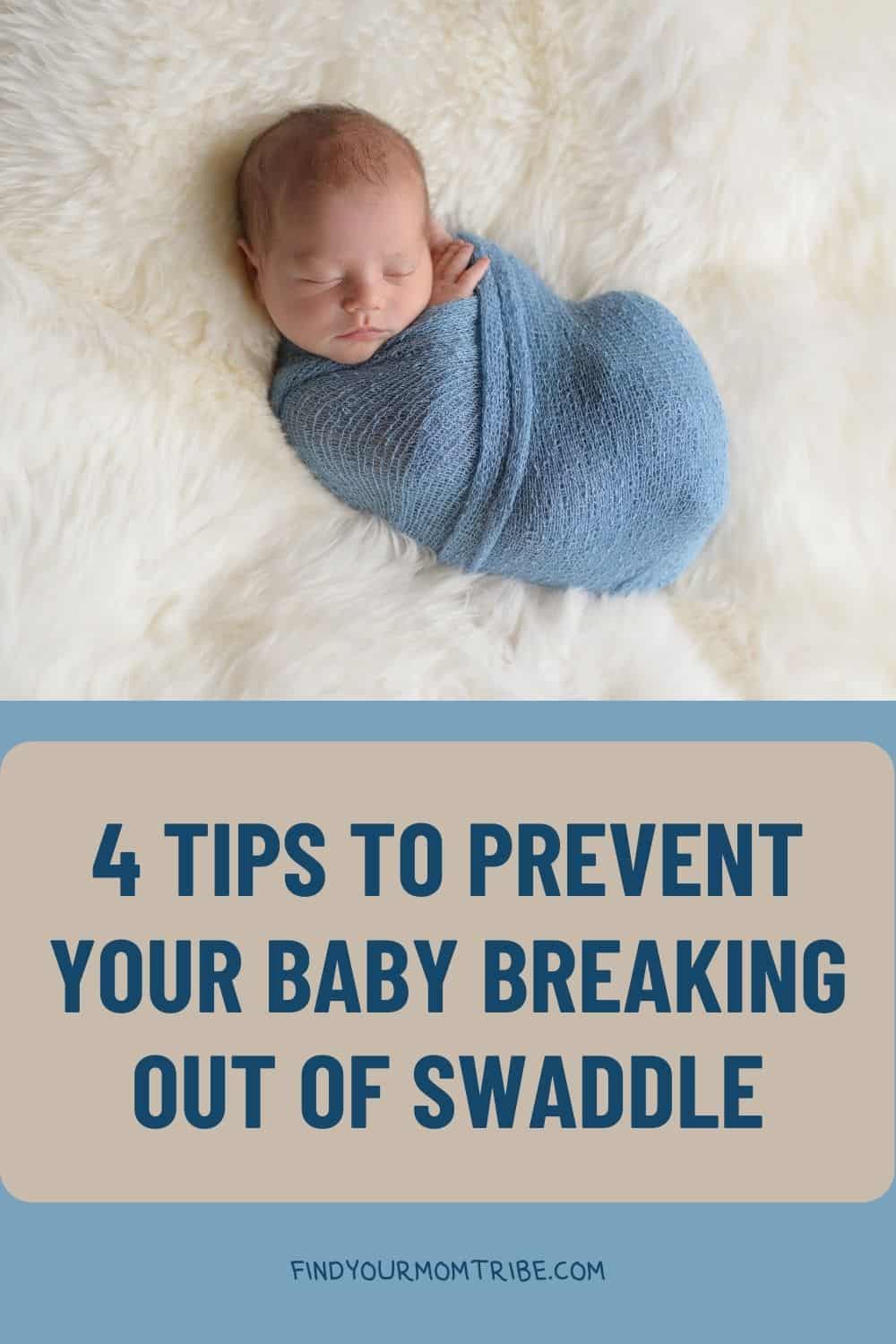There are several things that can be quite annoying when parenting, and one of the prime suspects is when you have your baby breaking out of swaddle.
While the baby breaking out of swaddle is by no means a big problem, it can turn into quite a nuisance when your little one starts flailing around and weasels out of it like a caterpillar emerging from a cocoon.
There are several reasons for this. The first is the child’s startle reflex, where the baby’s arms flail around wildly and cause him to eventually break out of his sleep sack.
The other is simply a poorly folded swaddle blanket, which brings considerable discomfort to your child and makes him resist the act of swaddling in the first place.
It’s not hard, but new parents usually don’t know what the right swaddling baby method is.
That’s why I decided to write this guide and help newcomers and veterans alike learn proper swaddling techniques to help prevent your baby breaking out of swaddle.
How To Stop Baby Breaking Out Of Swaddle

1. Use big, long blankets rather than small, short ones
Small blankets can’t really hold the necessary tightness for long enough. Some people may suggest it because it looks like a snug fit, but the truth is it’ll simply unravel quite quickly.
Larger blankets are better to use because you can wrap him up a lot tighter and make sure the wrap is secure as you have a lot more fabric to work with. An average of 44 square inches is recommended because that covers the average baby body.
Adjust as necessary, but make sure it’s not too big.
2. A fully loose blanket is a bad blanket
Having the blanket loose around the baby’s arms allows the child to fidget and cry a lot more as he doesn’t feel comfortable.
What he really wants is for his arms to be wrapped snugly, so they feel like they’re being embraced, while the baby’s legs and hips are left with some loose wiggle room to shuffle around in.
If you always make sure the baby’s chest area is nice and snug, you’ll find your little one is a lot less fussy than usual.
Of course, that may not be the case for every baby, but it’s worth noting if you find your little one crying and you can’t figure out why.
3. Make sure the blanket isn’t too big

While big blankets are good, blankets that are too big can be just as irritating for your child as small ones.
This is mostly because the little one usually hates it when the blanket brushes up against his cheeks as he’ll think it’s his mother’s breast, which tricks him into thinking it’s feeding time.
This is the effect of the rooting reflex, and when the child realizes that the nipple isn’t near him he’ll end up getting upset and is more than likely to cry.
Avoid this by finding a blanket that won’t touch your child’s cheeks and will keep your swaddled baby content and comfy in his little blanket.
The best way to help prevent this is by fashioning the swaddle into the shape of a V-neck sweater, instead of the standard burrito wrap shape.
That way you avoid any cheek-to-blanket contact.
4. Wrap the arms up straight instead of bent
I don’t mean your arms, but the baby’s!
While some parents like leaving their child hands-free, or with his arms bent so he has a bit of wiggle room to suck his thumb, it’s actually worse than keeping the arms in the swaddle straight.
Straight arms allow for a tight seal and a cozy environment for your child to rest in, but on the other hand, if you wrap the arms when they’re bent or leave room for him to move in general, it means the swaddle isn’t tightly wrapped and has a high chance of unraveling.
This will make it easier for him to break his way out of it like the Houdini he can be sometimes, especially during nap time.
When Should You Stop Swaddling?

Swaddling usually happens when the child is still a newborn, helping keep him protected for the initial period in a little warm fabric cocoon.
Then, when he gets to around 3-4 months of age, you’re meant to slowly start transitioning away from the swaddle and allowing the child to sleep independently in his crib.
This is because the need for safe sleep through swaddling is reduced thanks to his own muscles developing properly.
The transitioning process usually lasts about 1-2 months, or until your child is 4-5 months old.
Once successful, you can safely assume your child has had a developmental leap in his growth.
However, there are some children who enjoy the act of swaddling up until they’re a 6, to even a 9, month old child.
While it’s usually not recommended, as kids should start becoming a bit more active during that time, it’s by no means a cardinal sin.
However, you can go down the no swaddle route and replace it with an alternative that’ll feel similar, like a sleep suit or a wearable blanket.
Even a baby sleeping bag can work, though the former 2 are better options.
How To Properly Transition Out Of Swaddling?

Once your child reaches the point at which swaddling should be phased out, it can be a little bit tough to get him to drop it right away.
It might work for some, but a different approach might be needed for others. Here are 5 different ways to help solve the problem.
1. Dropping it cold turkey
If it feels like the swaddle blanket is more of a hindrance to your child’s sleep than a benefit, it might be time to ditch it altogether.
He certainly won’t miss it and will find it easier to fall asleep without it.
The same should be applied to kids who have outgrown swaddling, especially if the blanket keeps coming loose and poses a suffocation risk instead of a sleeping aid.
Sure, your child is likely to be upset for a few days, but it won’t last forever and he’ll forget all about it as soon as he gets accustomed to sleeping without a swaddle.
2. Using a swaddle alternative
If you don’t want to put your child through a small period of discomfort, then you can always opt for using a sleep sack or a wearable blanket to satisfy your child’s swaddling needs.
RELATED: 11 Best Sleep Sacks For Toddlers: Wearable Blankets You’ll Love
It does require a bit of monetary investment, but it will keep your child comfortable during his first year.
3. Starting the transition from the legs

This is one of the simpler methods as legs are usually more active, which is why this is one of the preferred transitioning methods.
Simply wrap the swaddle so your baby’s legs remain free but the arms are still tucked in for a few nights, then gradually set one arm free and then the other, until your child becomes accustomed to sleeping without the swaddle entirely.
4. Starting the transition from the arms
The alternative to #3, and the more common option, is to use the same method in reverse
This time, you have the child sleeping with one arm free for a few nights before swapping over to both arms, after which you can slowly move the swaddle away from the legs too.
Normally, the process stops at the end of the arms stage, but the leg stage might be necessary too.
5. Unswaddling during nap time
Some people also like unswaddling during nap time to ease the child into the idea that a swaddle isn’t necessary for sleep.
While the two forms of sleeping are handled differently by the human brain, one part will end up learning from the other and become accustomed to the prospect.
It’s a somewhat less consistent way of getting results but is a potential option if you want to avoid having to purchase extra baby gear.
How Long Does It Take To Move Away From The Swaddle?

While the process can vary from child to child, the estimated time frame is around 1-2 weeks if everything is in order.
If your child is having some trouble separating from the swaddle, or still has the Moro reflex present, it might take a bit longer.
Around 3-4 weeks, give or take a few days depending on other factors.
If something seems out of order, don’t hesitate to call your doctor, pediatrician, or any other qualified healthcare professional to ask for some medical advice on the matter.
As always, any advice from the internet, even if it comes from a trained medical professional, should be taken with a pinch of salt.
Why You Should Swaddle

By wrapping your baby up properly before sleep you reduce the chances of him accidentally rolling over, thereby preventing accidental suffocation and Sudden Infant Death Syndrome (SIDS).
This is why using a swaddle is highly recommended.
It also helps soothe your child’s Moro reflex (startle reflex) which almost always appears in newborn babies before disappearing on its own.
Swaddle or no swaddle?
Many people often ask if they should just give up on the idea, especially if their baby keeps escaping the swaddle.
But it honestly depends on what your child likes. Some kids really like it when they’re surrounded with comfort and they prefer it over not having it, while others aren’t as dependent on it and can do without it.
However, the kids who do enjoy being swaddled might have difficulties sleeping otherwise, and will definitely require the swaddling period.
Your child can get so attached to swaddling that he ends up having great trouble sleeping without it.
Should that be the case, you might need to take an even more gradual approach, to the point where you should include it as part of his sleep training.
Have him sleep without it until he wakes up for the first time in a night, and then wrap him up afterward.
Repeat for a few days/weeks and gradually start removing it until the need for it is completely gone.
What’s The Moro Reflex?

Another concern when trying to unswaddle your child is the Moro reflex, a completely natural occurrence that manifests in children at a young age and tends to fade when they’re 6-9 months old.
You can recognize it through a series of 3 actions the child performs in sequence: the spreading of the arms, the subsequent closing of the arms, and finally crying for a short period of time.
It’s a response that occurs when the babies feel like they’ve lost support.
It might feel rather odd to see it, but once you know what it is you’ll know how to deal with it.
This happens because the body is trying to determine how well its central nervous system responds to prompts.
It’s also believed that, given the nature of the movements, it’s meant to be a natural reflex of a child clinging to its mother if it senses any danger.
But what does this have to do with the topic at hand?
Well, this need for support may prove hard to overcome until it goes away naturally, and your child might need a swaddle to suppress the reflex.
If that’s the case, you have little choice but to let it play out until it’s completely gone.
You can test whether or not it’s gone by trying to unswaddle every week or so, or by trying to elicit the reflex by performing a gentle head drop.
How To Know When It’s Time To Start Getting The Baby Unswaddled?

While new parents may find it hard to figure out exactly when the right time to start unswaddling their child is, there are a few telltale signs that can help them recognize it quite easily.
1. The baby breaking out of the swaddle is becoming very frequent
The first, and most obvious sign, is when your child is actively starting to resist the blanket burrito you’ve put him in, to the point he starts getting upset.
That’s when you know it’s time to start moving away from the swaddle and allowing your little child to move onto the next stage.
2. The child starts actively working on his rolling skills
If you see your baby starting to include more complex movements into his daily fidgeting routine, like trying to roll over, it might mean it’s time to ditch the swaddle.
This is so your child doesn’t get stuck on his stomach when sleeping because he’s obstructed by the cloth.
3. The child wakes up more frequently in the night
If you notice your little one keeps waking up in the middle of the night and moving away from his intended sleep schedule, it might be because he’s starting to outgrow the need for a swaddle and is finding it more of a hindrance than a help.
4. The passing of the startle reflex
I’ve mentioned this one before, and it is one of the main reasons parents resort to swaddling in the first place because it helps keep the baby comfortable even when the parents aren’t nearby.
After all, we can’t be around our kiddos 24/7 as we need a rest too.
But, should the startle reflex begin to fade, it might be time to transition out of the swaddle.
Some Other Things That Might Help Make Unswaddling Easier

It’s no secret that kids will always be unpredictable, regardless of how much we want to be in control of the situation, and you’ll almost always have a baby breaking out of swaddle.
Thankfully, there are other methods that might help get him to calm down or to go to sleep. They’re all great ways of helping parents who are struggling to figure out how to get their baby to sleep without a swaddle.
1. Pacifiers
The #1 tool in every parent’s arsenal when it comes to calming fussy children down is the almighty pacifier.
While better suited for daily naps, so you can move it out of the baby area if it falls out, it’s always been a great tool to use as a soother for newborns and toddlers.
2. A white noise machine
While merely a novelty for some older parents, a white noise machine is a perfect way to help your child fall asleep without having to rely on a swaddle to keep him calm.
The soft, soothing noises from the machine will help mellow him out and calm him enough to get back to sleep, helping to keep him on a more regular sleep schedule.
3. A fresh diaper change before bed
A very simple trick, but one that many parents often neglect, especially with their first baby.
The cause of a baby’s sudden wake-ups may not be a lack of comfort from being put in a swaddle wrap, but rather that he’s sleeping in a wet diaper.
That’s why giving him a fresh diaper change before bed is an effective way of keeping him calm.
It’ll keep his bum nice, clean, and comfy and help put him at ease, allowing you to potentially keep him unswaddled.
In Conclusion

If your baby is breaking out of his swaddle a lot more often than normal, it can be due to a great number of reasons.
It can either be because of a poor wrap, with the baby’s arms bent and loose space left, or a blanket that’s either too small or too large.
If, however, the baby has already accepted swaddling before and is around 4-5/6-9 months of age, you might have the baby breaking out of swaddle because he’s ready to sleep without it.
Some babies never take to being wrapped up like a burrito.
Although it’s by no means mandatory, it does help deal with a baby’s startle reflex as well as help reduce the chances of SIDS occurring, not to mention that it’s quite a comfortable method of holding your infant.
Every baby is different and will exhibit this in different ways for different reasons, so it’s up to you to figure it out.
If you find yourself lost, remember that you can always consult your doctor or pediatrics professional on the matter.
They’ll be able to provide more valuable input than I can because they can diagnose the problem better in person.
If you need some extra help with transitioning, or just helping your child fall asleep easier through alternative means, you can always try some of the items listed above as well.
I wholeheartedly recommend getting a white noise machine as it was a lifesaver for my kiddo.
I hope this has managed to give you some insight into why you have a baby breaking out of swaddle and what to do about it.
Until next time, Mammas.
Like this post? Please share or pin it for later. You can also stay in the loop and follow us on Facebook, Instagram or Pinterest.

We love honesty! Find Your Mom Tribe is an Amazon Associate and we earn from qualifying purchases through affiliate links at no extra cost to you. Please see our full Amazon Affiliate disclosure for more information.

